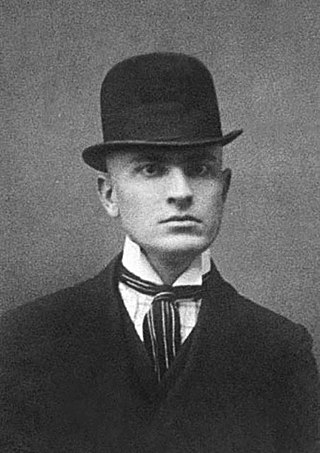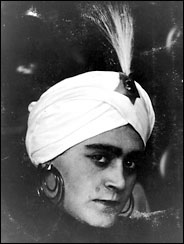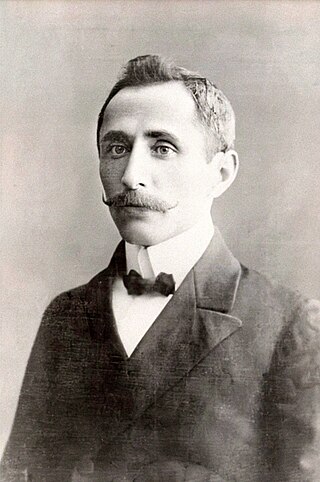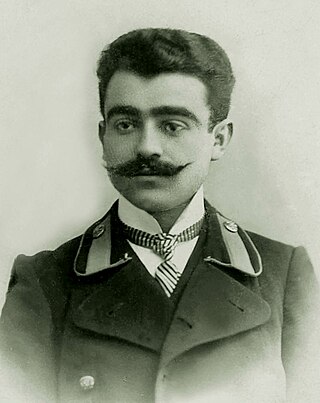
Grigol Robakidze was a Georgian writer, publicist, and public figure primarily known for his prose and anti-Soviet émigré activities.

Shusha District is one of the 66 districts of Azerbaijan. It is located in the west of the country and belongs to the Karabakh Economic Region. The district borders the districts of Khojaly, Lachin, and Khojavend. Its capital and largest city is Shusha. As of 2020, the district had a nominal population of 34,700.

Kurban Said is the pseudonym of the author of Ali and Nino, a novel originally published in 1937 in the German language by the Austrian publisher E.P. Tal. The novel has since been published in more than 30 languages. The true identity of the author is in dispute.

Lev Nussimbaum, who wrote under the pen names Essad Bey and Kurban Said, was a writer and journalist, born in Kiev to a Jewish family. He lived there and in Baku during his childhood before fleeing the Bolsheviks in 1920 at the age of 14. In 1922, while living in Germany, he obtained a certificate claiming that he had converted to Islam in the presence of the imam of the Turkish embassy in Berlin. He created a niche for himself in the competitive European literary world by writing about topics that Westerners, in general, knew little about - the Caucasus, the Russian Empire, the Bolshevik Revolution, newly discovered oil, and Islam. He wrote under the name of Essad Bey in German.
Blood and Oil in the Orient was the first book written by Essad Bey, penname for Lev Nussimbaum (1905–42). The book was first published in 1929 when Essad Bey was only 24 years old. During the following eight years (1929–36), 16 books were published under his name.

Firidun bey Ahmad bey oglu Kocharli or Kocharlinski was a prominent Azerbaijani writer, philologist, and literary critic.

Azerbaijan State University of Economics is a public university located in Baku, Azerbaijan. UNEC was founded in 1930 and it is one of the biggest educational institutions of the South Caucasus. UNEC has 14 faculties, where 18.5 thousand students get education, and it offers master programs in 57 specialties, employing more than 1000 teachers, including 62 professors and 344 docents, among whom there are active members of the Azerbaijan National Academy of Sciences, New York Academy of Sciences, winners of state awards, honored teachers and scientists. UNEC is a full member of the European University Association, Federation of the Universities of the Islamic World, University Council of Organization of the Black Sea Economic Cooperation and Eurasian Association of Universities. Foreign students enrolled in undergraduate and graduate courses at UNEC are approximately 650 out of 18,400 student enrollment overall.

Ali and Nino is a novel about a romance between a Muslim Azerbaijani boy and Christian Georgian girl in Baku in the years 1918–1920. It explores the dilemmas created by "European" rule over an "Oriental" society and presents a tableau portrait of Azerbaijan's capital, Baku, during the Azerbaijan Democratic Republic period that preceded the long era of Soviet rule. It was published under the pseudonym Kurban Said. The novel has been published in more than 30 languages, with more than 100 editions or reprints. The book was first published in Vienna in German in 1937, by E.P. Tal Verlag. It is widely regarded as a literary masterpiece and since its rediscovery and global circulation, which began in 1970, it is commonly considered the national novel of Azerbaijan. The English translation, by Jenia Graman, was published in 1970.
Baron Omar Rolf von Ehrenfels was a prominent Muslim of Austrian origin.

Abdulla Shaig, born Abdulla Mustafa oglu Talibzadeh, was an Azerbaijani writer.

Mir-Hasan Kazim oglu Vazirov, also spelled Vezirov was an Azerbaijani socialist revolutionary. Vazirov participated in revolutionary movements in the Russian Empire from his youth, for which he was persecuted by the authorities. Later on, he joined the Socialist-Revolutionary Party and became one of the 26 Baku Commissars. He is the great-grandson of Mirza Ali Muhammad Aga, vizier of Ibrahim Khalil Khan of Karabakh Khanate.

Mikayil Mushfig was an Azerbaijani poet of the 1930s.

Yusif Vazir Chamanzaminli, also spelled Chemenzeminli, born Yusif Mirbaba oghlu Vazirov was an Azerbaijani statesman and writer known for his novels, short stories, essays, and diaries. Evidence points to the fact that Chamanzaminli was the primary core author of the famous romance novel Ali and Nino first published in 1937 in Austria under the pen-name of Kurban Said.

The Snake's Skin is a novel by prominent Georgian writer Grigol Robakidze. It was written and published in the Georgian and German languages.

Jamil Hasanli is an Azerbaijani historian, author and politician. He served as a professor at Baku State University in 1993–2011 and as a professor at Khazar University in 2011–2013. He was an advisor to the President of Azerbaijan in 1993 and served two terms in the Parliament of Azerbaijan between 2000 and 2010. He was the main opposition candidate in the 2013 Azerbaijani presidential election where he came in second with 5.53% of votes. He has been the leader of National Council of Democratic Forces of Azerbaijan since 2013.

Shusha Realni School was a school with six classes, located in Shusha, Azerbaijan, in the disputed region of Nagorno-Karabakh. The school's building phase was completed in 1881. The school stopped its work following the capture of Shusha by Armenian forces in 1992 and now lies in a ruined state.













